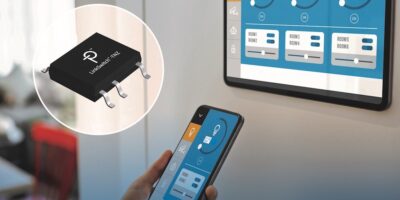LinkSwitch-TNZ blends lossless zero cross detection with offline power conversion
Lossless zero cross detection and offline power conversion, with the option fo x-capacitor discharge functionality, have been incorporated into LinkSwitch-TNZ offline switcher ICs by Power Integrations.
The switching power supply IC is supplied in a compact SO-8C package. The LinkSwitch-TNZ IC can be used for non-isolated buck and buck-boost power supplies up to 575mA output current and provides up to 12W output for universal-input isolated flyback designs.
The ICs provide a signal indicating that the sinusoidal AC line is at 0V, explained Adnaan Lokhandwala, product marketing manager at Power Integrations. “This signal is used by smart home and building automation products and appliances to control the switching of relays, IGBTs and TRIACs to minimise switching stress and system in-rush current,” he said. LinkSwitch-TNZ’s detection of the zero cross point consumes less than 5mW, allowing systems to reduce standby power losses compared with alternative approaches that require 10 or more discrete components and burn 50 to 100mW of continuous power, he added.
Devices such as light switches, dimmers, sensors, and plugs connect and disconnect the AC line periodically using a relay or TRIAC. A discrete circuit is typically implemented to detect the AC line zero-crossing to control the turn-on transition of the main power device while reducing switching losses and in-rush current. This is a component-intense approach, is lossy and consumes almost half of the standby power budget in some cases, noted Power Integrations. Similarly, appliances often use a discrete zero-cross detection circuit to control motor and microcontroller timing. They also require an auxiliary power supply for functions such as wireless connectivity, gate drivers, sensors and displays.
LinkSwitch-TNZ ICs are claimed to provide best-in-class light load efficiencies, enabling more system features to be powered. At the same time they meet standby regulations such as the European Commission (EC) standard for home appliances (1275), which requires equipment to consume no more than 0.5W in standby or in off mode. They also comply to Energy Star’s version 1.1 for Smart Home Energy Management Systems (SHEMS), which limits standby consumption of smart lighting control devices to 0.5 W and China’s GB24849, which limits the off-mode power consumption in microwave ovens to 0.5W. LinkSwitch-TNZ ICs also reduce component count by 40 per cent or more when compared to discrete designs, said Power Integrations.
The x-capacitor discharge function can be included as an option in the package for high power applications. It reduces PCB space, lowers bill of materials costs and increases reliability, claimed Power Integrations.
LinkSwitch-TNZ switching power supply ICs enable ±3 per cent regulation across line and load. They have no-load consumption of less than 30mW with external bias and have an IC standby current of less than 100 microA. The ICs have an integrated soft start and work with both isolated and non-isolated topologies.




